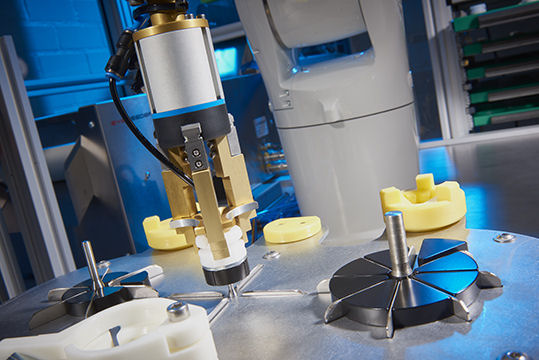The robot recently commissioned at Goudsmit Magnetics simplifies the production process for magnet assemblies. Such magnets have applications in the automotive, high-tech, aerospace and medical industries, among others. Moreover, the lean manufacturing method that Goudsmit also employs leads to higher overall assurance of the magnet assembly and prevents waste.
Greater efficiency
This means greater efficiency and less downtime. The robot also overcomes all the problems a manufacturer encounters when assembling a magnet system, such as how to glue magnetized parts that tend to stick together. An additional advantage is that Goudsmit can work with you early on in the process to find the most suitable production method for the magnet system concerned, as well as test it straight away through the use of 3D magnet calculations and rapid prototyping.
RobofrOK
The production process, for magnet assemblies for example, is divided into steps, each of which must meet its own quality requirements and be 100% in accordance with specifications. This is also reflected in the name of the process: RobofrOK, with a robot frog as symbol, which stands for ‘first run okay’, a concept that is very important in the automotive industry, for example. They strive for a 0-PPM (zero parts per million) rejection rate. See how it works in this video.
Certified
The assemblies constructed by the RobofrOK process include magnetic grippers, magnetic coils, glued magnet segments or sandwich systems for the high-tech and automotive markets. For magnet components, Goudsmit is ISO 9001:2008, ISO/TS 16949:2009 and AS 9100D certified, and the company is working to achieve these certifications for the production environment too. This is also important for the industries mentioned.
Process
An actuator is a good example of a magnet assembly that a manufacturer can assemble itself but which the robot can handle better and more efficiently. An actuator may consist of a number of neodymium (Nd-Fe-B) magnet segments that must be glued to a shaft.
Position magnet segment
This can be done manually, but since the manufacturer always receives the magnets premagnetized, they must first be separated. Then each magnet segment must be positioned on a shaft and held in place until the glue has hardened, after which the next magnet must be glued. This is a very labour-intensive process, and each subsequent magnet encounters more resistance; the more magnets, the stronger the total package becomes.
Magnetization
Goudsmit makes the magnets first, after which magnetization takes place during the process. A conveyor supplies the segments, and the robot picks them off. Next, the magnet segment passes a camera to check for cracks or flaws, and then it reaches the magnetization coil. After this, the robot places the segments in the tooling unit one by one, where they are brought together and glued. The robot is not bound by any particular magnet shape and is therefore flexible.
More information? Please use the contact form

